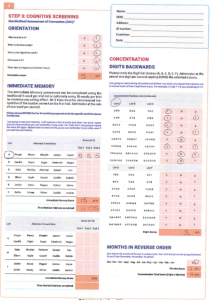In this hour, I conducted a SCAT test on one of the players in the BUCs hockey team. The player had got hit with a hockey stick in the back of the head during Saturday league, so needed to be assessed for concussion.
Reflective Summary
SCAT5 is a standardized tool for evaluating concussions. At the start of the BUCs season the player had to participate in bassline testing, as it can be useful for interpreting post-injury test scores. There are 6 steps that need to be completed as part of an off-field assessment; athlete background, symptom evaluation, cognitive screening, neurological screen, delayed recall and then coming to a decision. Cognitive screening also includes orientation, immediate memory and concentration (digits backwards and months in reverse order). The neurological screen consists of a balance examination, where the therapist counts the number of errors that the athlete makes during a double leg stance, single leg stance and tandem stance.
Areas for further improvement
My first area for further improvement would be to consider the aftercare advise for concussion. After I performed the SCAT test, the only advice that I gave was concerning playing and training. As he still had staples in his head he was told by the hospital to not participant in sport for at least 2 weeks. Next time I need to inform the player to avoid alcohol and driving. They also need to be cleared by a healthcare professional before they can return to play/sport. Another improvement would be for me to revise the graduate return to sport strategy. It is important to remember that each step of progression should last at least 24 hours and if any symptoms worsen while exercising, the player has to go back to the previous stage.
Things to Remember
- Scoring on the SCAT5 should not be used as a stand-alone method to diagnosis concussion
- With the balance tests, the type of errors includes hands lifting off the iliac crest, opening eyes, lifting forefoot or heel, remaining out of position for up to 5 seconds, step, stumbling or falling or moving the hip into more than 30 degrees of abduction
- Check post injury results against bassline data
- If any athlete is suspected of having a concussion, they should be removed from play immediately and seek medical attention
- Resistance training should only be added in the later stages of the graduated return to play
Link to an example SCAT form = SCAT5
Clients SCAT test:





